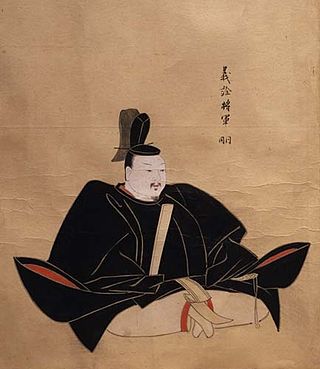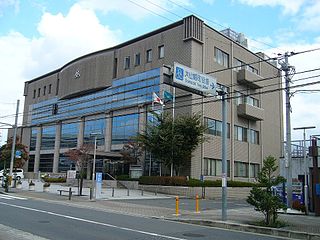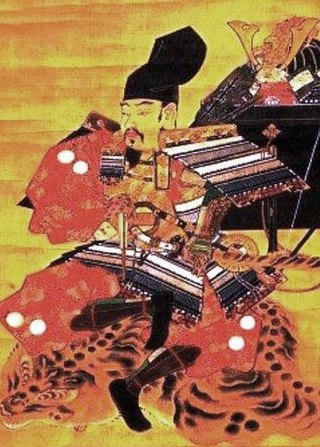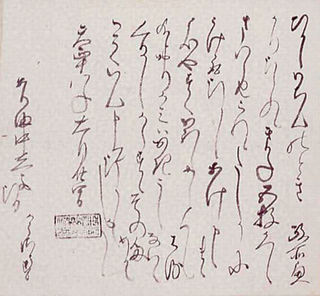Related Research Articles

The Kamakura period is a period of Japanese history that marks the governance by the Kamakura shogunate, officially established in 1192 in Kamakura by the first shōgun Minamoto no Yoritomo after the conclusion of the Genpei War, which saw the struggle between the Taira and Minamoto clans. The period is known for the emergence of the samurai, the warrior caste, and for the establishment of feudalism in Japan.

Ashikaga Yoshiakira was the second shōgun of the Ashikaga shogunate who reigned from 1358 to 1367 during the Muromachi period of Japan. Yoshiakira was the son of the founder and first shōgun of the Muromachi shogunate, Ashikaga Takauji. His mother was Akahashi Tōshi (赤橋登子), also known as Hōjō Nariko.

Ashikaga Takauji also known as Minamoto no Takauji was the founder and first shōgun of the Ashikaga shogunate. His rule began in 1338, beginning the Muromachi period of Japan, and ended with his death in 1358. He was a male-line descendant of the samurai of the (Minamoto) Seiwa Genji line who had settled in the Ashikaga area of Shimotsuke Province, in present-day Tochigi Prefecture.

Yawata is a city located in Kyoto Prefecture, Japan. As of 31 July 2023, the city has an estimated population of 69,306 in 33972 households and a population density of 2800 persons per km2. The total area of the city is 24.35 square kilometres (9.40 sq mi). The Iwashimizu Hachiman-gū is located in Yawata.
Kyōtanabe is a city located in the southern part of Kyoto Prefecture, Japan. As of 1 September 2023, the city has an estimated population of 71,757 in 31555 households and a population density of 1700 persons per km2. The total area of the city is 42.92 square kilometres (16.57 sq mi).

The Nanboku-chō period, spanning from 1336 to 1392, was a period that occurred during the formative years of the Muromachi (Ashikaga) shogunate of Japanese history.

The Boshin War, sometimes known as the Japanese Revolution or Japanese Civil War, was a civil war in Japan fought from 1868 to 1869 between forces of the ruling Tokugawa shogunate and a coalition seeking to seize political power in the name of the Imperial Court.

Ōyamazaki is a town located in Otokuni District, Kyoto Prefecture, Japan. As of 1 September 2023, the town has an estimated population of 16,219 in 6722 households and a population density of 2700 persons per km². The total area of the town is 5.97 square kilometres (2.31 sq mi).

Shōhei (正平) was a Japanese era of the Southern Court during the Era of Northern and Southern Courts after Kōkoku and before Kentoku. This period spanned the years from December 1346 to July 1370. The Southern Court emperors in Yoshino were Emperor Go-Murakami and Emperor Chōkei. The emperors in Kyoto were Emperor Kōmyō, Emperor Sukō and Emperor Go-Kōgon in the north.

Kusunoki Masashige was a Japanese military commander and samurai of the Kamakura period remembered as the ideal loyal samurai.

Nitta Yoshisada also known as Minamoto no Yoshisada was a samurai lord of the Nanboku-chō period Japan. He was the head of the Nitta clan in the early fourteenth century, and supported the Southern Court of Emperor Go-Daigo in the Nanboku-chō period. He famously marched on Kamakura, besieging and capturing it from the Hōjō clan in 1333.

The Battle of Minatogawa, also known as the Battle of Minato River, was part of the Nanboku-chō Wars fought near the Minato River in Settsu Province on 5 July 1336.

The Genkō War, also known as the Genkō Incident, was a civil war fought in Japan between the Emperor Go-Daigo and the Kamakura Shogunate from 1331 to 1333. The Genkō War was named after Genkō, the Japanese era corresponding to the period of 1331 to 1334 when the war occurred.

Kusunoki Masanori was a samurai who fought for the Southern Court in Japan's Nanboku-chō Wars, and is famed for his skills as a leader and military strategist, though he later sought a diplomatic solution and was regarded a traitor by many of his comrades. He was the brother of Kusunoki Masatsura and Kusunoki Masatoki, and son of Kusunoki Masashige.

Bunna (文和), also romanized as Bunwa, was a Japanese era name of the Northern Court during the Era of Northern and Southern Courts after Kannō and before Enbun. This period spanned the years from September 1352 through March 1356. The emperor in Kyoto was Emperor Go-Kōgon (後光厳天皇). Go-Kōgon's Southern Court rival in Yoshino during this time-frame was Emperor Go-Murakami (後村上天皇).

The Kannō disturbance or Kannō incident, also called Kannō no juran, was a civil war which developed from antagonisms between shōgun Ashikaga Takauji and his brother, Ashikaga Tadayoshi, thus dividing and weakening the early Ashikaga shogunate. These events are labeled Kannō after the Japanese era or nengō which was proclaimed by the Northern Court during the years 1350 through 1351 in the Nanboku-chō period of Japanese history. One of the main effects of the Disturbance was the re-invigoration of the Southern Court's war effort due to the flow of renegades from Kyoto who followed Tadayoshi to the Southern capital of Yoshino, near Nara.
Statistics of Emperor's Cup in the 1958 season.
Statistics of Emperor's Cup in the 1962 season.

Prince Kaneyoshi was a nobleman of the Kamakura period and the early Nanboku-chō period where power in Japan was split between two rival factions. He was the son of Emperor Go-Daigo who was head of one of the factions, the other being the Ashikaga shogunate.

Kōzōsu (孝蔵主) was a Japanese noble lady, aristocrat and retainer of the Toyotomi clan. She was the daughter of Kawazoe Katsuhige, a retainer of the Gamō clan. She was an elite female officer under Nene's command and chief secretary to Toyotomi Hideyoshi.
References
- George Bruce. Harbottle's Dictionary of Battles. (Van Nostrand Reinhold, 1981) ( ISBN 0442223366).